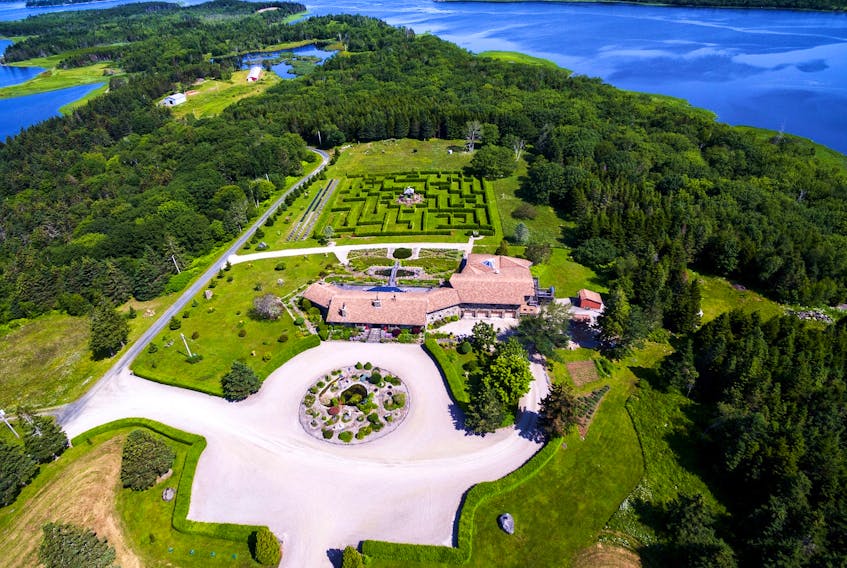ROBERTS ISLAND, N.S. — James Hilton, the author of Lost Horizon, described a fictional place called Shangri-La in his book. He described it as an imaginary paradise on earth, a remote and exotic utopia. Shangri-La is real, every bit as beautiful as imagined, and carries a price tag of $7,890,000 on Roberts Island in Yarmouth County.

It was a tough decision for the owners to list their property for sale. The founder, Baron Carlo Amato is in poor health and now living in Miami, Florida. It’s difficult for him to travel and he cannot enjoy the estate as he once did but he still reflects on the many wonderful memories of the realization of his dream.
More than half a century ago, an acquaintance mentioned that he owned land in Nova Scotia to the baron - Carlo Camillo Amato Chiaramonte-Bordonaro.
Baron Amato was intrigued. He and his late wife Lorraine arrived in Nova Scotia in 1959, looking for a secluded and private space – land on which they could create “heaven on earth” to relax, renew energy and enjoy time with family and friends. When they stood on the site where the main house is located now and saw themselves surrounded by nature, the ocean, and wildlife, they fell in love with it, and he named it Shangri-La, a paradise on earth.

There was nothing but grazing sheep on the land where the main house was built and is located now. A farmhouse, constructed in 1909, was already there. Baron Amato had it renovated, and that’s where they lived for many years until the main house was finished and livable.
He took into consideration “the striking views, the everchanging sunsets, and the luminosity of the sky” when choosing the homestead location.
He designed nearly every single detail of the home and property, including many furniture pieces, using the best quality materials and the latest and most modern amenities at that time.

The first phase took five to seven years. The pool pavilion was added in the 1970s, then more guest bedrooms in the late ’90s. More improvements were made in the 2000s. He planted several thousand spruce trees to provide shelter and food for birds and mandated that flora and fauna be respected and appreciated in Shangri-La.

In the early years, Baron Amato spent a lot of time working on the property, supervising details, landscaping, and more. Later, he enjoyed his time horseback riding, cooking, writing his book on wild boars, raising wild boars - a passion of his since childhood – as well as entertaining family and friends from all over the world.
Baron Amato is an avid conservationist, and his personal interest in wild boars developed out of his early hunting experiences in Europe; he has been knighted in several countries for the protection of natural resources and was an assistant professor of biology at Georgia State University, 1971 to 1981.
Around that time, from Georgia State University, he brought the wild boars to continue studying them in captivity and breed them under controlled conditions to write a complete essay on the Wild Boar: A Complete Study of Sus Scrofa (Wild Boar). He initially was able to maintain a herd of up to 200 wild boars. Nowadays, there are none on the property.

In 2003, he married Irela Fabiola Lopez Fonseca, an artist, and textile designer.
She says Shangri-La, now 60-years-old, keeps evolving, and her husband’s creative genius is behind it all.
Part of the kitchen is virtually walled in history. While Baron Amato was driving in Yarmouth one day, he saw a pile of bricks being discarded from the demolition of the old Grand Hotel. He asked if he could purchase the salvageable bricks then had them delivered and built the kitchen walls with them, where they can still be enjoyed.

Many well-known personalities in art and film, like Gina Lollobrigida, environmentalists like Jim Fowler, members of royal families, government officials, global business people, and others, have visited Shangri-La throughout the years.
Baroness Amato says many came to recharge their energy, others to write books, to enjoy the pristine natural surroundings, and yet others to participate in culinary experiences and art retreats.
“If the walls could talk, they would speak of the wonderful times spent here. Even though we intended to remodel our main kitchen, we haven’t since it is filled with so many beautiful memories that it doesn’t feel right. After all, the main kitchen in Shangri-La is the point of origination for Pasta Primavera,” she says.
In the 1970s, Siro Maccioni, owner and Jean Vergnes chef and co‐owner of the famous Le Cirque Restaurant in Manhattan, and Chef Luigi Nanni, Chef Pierre Franey and Craig Claiborne, and other guests were invited to Shangri-La.
Baron Amato describes how the chefs wanted to create wild boar recipes like Nanni’s ‘Sella de Cinghiale Shangri-La’ or Jean Vergnes’ ‘Cotes de Marcassin Sauce Robert’ (for Roberts Island), but after eating so much meat, they wanted something fresh and different.
“So Sirio Maccioni and his wife Egidiana, with their Italian spontaneity, threw ingredients at hand together, and Pasta Primavera was born at Shangri-la, on Roberts Island,” he says.

For Irela, it was the gardens that enraptured her.
“From the moment I arrived, I recognized Shangri-La as a retreat for the soul, body, mind, and spirit. It is a healing place. Nova Scotia is indeed a beautiful province, and when I arrived here 17 years ago, I fell totally in love with this place. I love beauty, and I feel inspired by it, and so my inner creativity was unleashed,” she says.
On the spacious lawn, she designed a labyrinth with a hand-made, one-of-a-kind gazebo in the center representing dreams and goals. The lavender garden, her “silence garden,” came next, with red roses in the center. There’s also a koi fish pond that brings her much happiness, the cultivation of organic vegetables/fruit, the culinary experiences, and the joy of painting in her silk-painting studio with striking views of the coastline.
“None of this would have been possible without the help of my friends and collaborators that have worked hand-in-hand with us to continue creating and maintaining this piece of heaven-on-earth, and for that, I am so very grateful. Shangri-La to me is its peaceful moments, stunning sunsets, starry nights, the sound of silence, the togetherness with nature, the sharing and laughter with dear friends, the good and healthy living. Shangri-La is indeed a retreat for the soul. It’s a state of mind. We should all find our Shangri-La,” says Baroness Amato.
More about the property
Shangri-La is a family compound consisting of a spacious main house and a guest house with separate caretaker's quarters. These are the three primary living areas, and together with other outbuildings meld to create a gated and secluded waterfront retreat on 288 acres of natural surroundings.
Gardens, large decks, fish ponds, and the labyrinth and lavender gardens are just a few of the attractions. On the lower level of the main house, there is a heated indoor pool, gym, sauna and a four-car garage.
There are multiple outbuildings, including warehouse storage, artist studio/boathouse with a marine railway, wharf, tool sheds, barn, generator, and the 1.5 story guest house.
The guesthouse is currently listed on Airbnb.

More about Baron Carlo Amato
A detailed account of Baron Carlo Amato’s many achievements can be found in his Marquis Who’s Who lifetime achievement award write-up.








